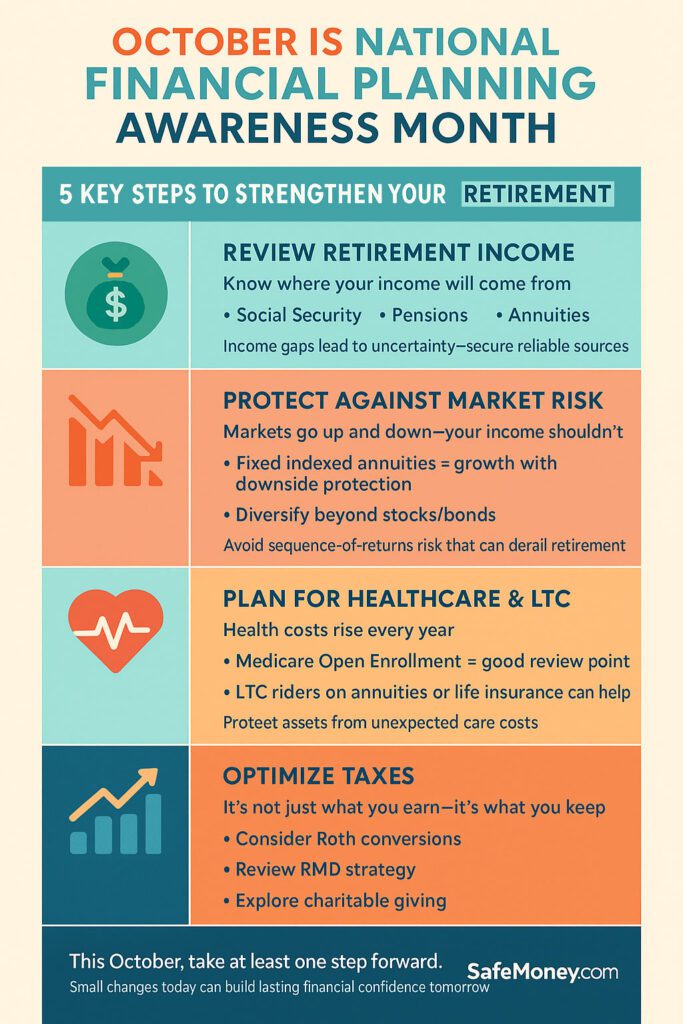October Is National Financial Planning Awareness Month

Why October Matters for Your Finances
Every October, National Financial Planning Awareness Month serves as a reminder to pause, reflect, and take action on your long-term financial goals. Just as people use spring for “cleaning up” their homes, October is a chance to organize your financial life before year-end.
For retirees and those approaching retirement, this awareness month is more than just a calendar event—it’s an opportunity to evaluate whether your plan for income, taxes, insurance, and investments is truly built to last a lifetime.
At SafeMoney.com, we created this article to answer the most common questions retirees and pre-retirees have about financial planning, retirement income strategies, and how new laws, taxes, and market conditions can impact your nest egg.
What Is Financial Planning Awareness Month?
National Financial Planning Awareness Month was established to highlight the importance of setting financial goals, creating a strategy to reach them, and making sure your plan stays on track as life changes.
Key aspects include:
- Budgeting & Cash Flow – Understanding how much you spend versus save.
- Retirement Income Planning – Ensuring your money lasts as long as you do.
- Insurance Protection – Life insurance, long-term care coverage, and annuities.
- Tax Efficiency – Reducing unnecessary taxes on Social Security, IRAs, and 401(k)s.
- Estate Planning – Making sure your legacy is protected for loved ones.
When done right, financial planning isn’t about restricting yourself—it’s about creating confidence and security for the future.
Why Planning Is More Important Than Ever in 2025
With inflation, rising healthcare costs, and uncertainty in the markets, today’s retirees face challenges previous generations didn’t. According to the Insured Retirement Institute, only about 24% of Baby Boomers are confident they have enough saved to last through retirement.
October is the perfect time to reassess your strategy because:
1. Year-End Deadlines Are Approaching
- RMDs (Required Minimum Distributions) must be taken by December 31.
- Charitable giving strategies can reduce taxable income.
- Last-minute IRA or Roth conversions can optimize your tax bracket.
2. Healthcare Costs Are Rising
- Medicare open enrollment overlaps with Financial Planning Month. This is an ideal time to evaluate your healthcare coverage alongside your retirement income strategy.
3. Longevity Is Changing the Game
- People are living longer, which means your income may need to stretch 25–30 years. Planning for guaranteed income sources—like annuities—can help.
5 Key Steps to Take During Financial Planning Awareness Month
1. Review Your Retirement Income Plan
Ask yourself: Do you know exactly how much income will come from Social Security, pensions, annuities, and your investments? Many people underestimate how much they’ll need.
✍️ Tip: Traditional rules of thumb—like the “4% withdrawal rule”—may no longer be reliable in today’s environment of longer lifespans, higher healthcare costs, and unpredictable markets. Instead of relying on a single percentage, consider building a retirement income plan that blends guaranteed sources (such as annuities or pensions) with flexible withdrawals from savings and investments. This approach can help ensure your money lasts as long as you do, no matter what the markets bring.
2. Protect Against Market Risk
The last few years have shown how quickly markets can shift. If too much of your retirement money is exposed to volatility, a downturn could force you to lock in losses.
Safe Money Strategy: Consider products like fixed indexed annuities, which allow you to participate in potential market gains without suffering losses from downturns.
3. Address Healthcare and Long-Term Care Costs
Medicare doesn’t cover everything, and long-term care can quickly drain savings. Exploring solutions like hybrid annuities or life insurance with long-term care riders can provide extra protection.
4. Optimize for Taxes
Retirement isn’t just about how much you have saved—it’s about how much you keep after taxes. Roth conversions, charitable giving strategies, and careful RMD planning can help reduce lifetime tax burdens.
5. Revisit Your Estate Plan
Your estate plan is more than just a will—it includes trusts, beneficiary designations, and powers of attorney. Keeping this updated ensures your wealth is transferred smoothly and in line with your wishes.

The Role of Life Insurance and Annuities in Financial Planning
Two tools often misunderstood, but essential, are life insurance and annuities.
- Life Insurance provides both protection and, in the case of cash-value policies, potential tax-advantaged growth. It ensures loved ones are cared for.
- Annuities act like a personal pension—providing guaranteed income you cannot outlive. Some annuities even offer enhanced benefits for long-term care.
Together, these solutions help balance growth, protection, and income in retirement.
Financial Literacy Is the Foundation
Financial planning awareness month is also about education. Without financial literacy, it’s easy to make costly mistakes, like claiming Social Security too early, taking unnecessary investment risks, or neglecting tax strategies.
Improving your financial literacy means asking questions, reading trusted resources, and working with advisors who focus on your goals—not just selling products.
Common Financial Planning Myths
- “I don’t have enough money to need a plan.”
✍️ Truth: Everyone benefits from a plan, even if you’re just starting or living on a modest income. - “Social Security will cover everything.”
✍️ Truth: On average, Social Security replaces only about 40% of pre-retirement income. Most people need 70–80%. - “Annuities are too complicated.”
✍️ Truth: While some annuities can be complex, fixed and fixed indexed annuities are straightforward and focus on income security.
Taking Action This October
Financial planning isn’t a one-time event—it’s an ongoing process. This October, commit to at least one action step:
- Meet with a trusted advisor.
- Run a retirement income calculation.
- Update your will or beneficiaries.
- Explore annuity or life insurance options for added protection.
Even small steps now can create major confidence later.
What to Expect From This Series
Throughout October, we’ll be publishing articles on:
- How to calculate your “magic number” for retirement income
- The cost of waiting to create a plan
- How annuities and Medicare work together
- Myths and truths about life insurance in retirement
- Real stories of retirees who secured their financial future
Stay tuned each week for insights designed to help you move from confusion to confidence with your retirement planning.
Final Thoughts
October’s National Financial Planning Awareness Month is the perfect time to step back and ask: Am I truly prepared for the future? By reviewing income strategies, tax planning, insurance coverage, and estate documents, you’ll gain more peace of mind—and a stronger plan to protect what matters most.
🧑💼 Written by Brent Meyer, founder of SafeMoney.com. With more than 20 years of experience helping families navigate retirement and legacy planning, Brent is committed to making financial education simple, clear, and trustworthy.
Disclaimer: This article is for educational purposes only and should not be considered financial, tax, or legal advice. Consult with a licensed professional regarding your specific situation. SafeMoney.com is not affiliated with or endorsed by any government agency.








